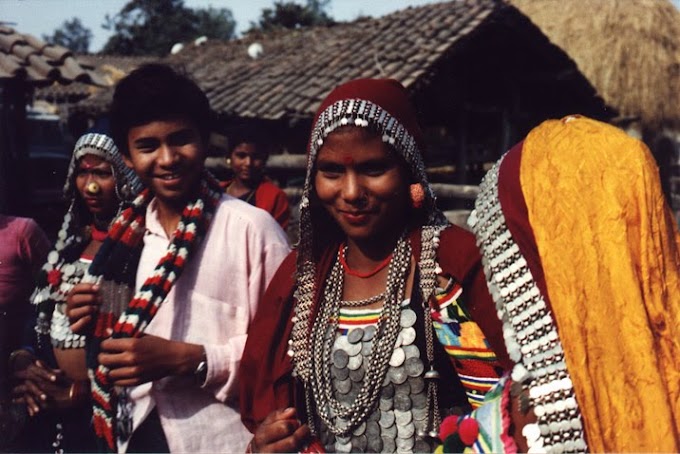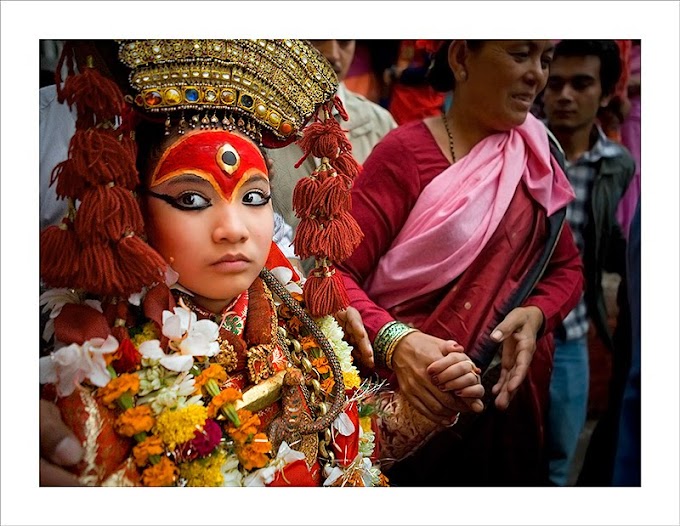The ‘Indigenous Peoples Trail' is in Ramechhap District of Nepal.The first of its kind in Nepal, the ‘Indigenous Peoples Trail’ offers unique, living, exposure to one of the most culturally diverse areas of Nepal. The ‘Indigenous Peoples Trail’ offers scenic trekking at relatively low elevations, below 3000M. Bound by Thulo Sailung peak in the North, the golden Sun Koshi flowing along the South and the Tama Koshi in the East, the ‘Indigenous Peoples Trail’ presents an incomparable and natural blend of cultural, linguistic and ethnic diversity coupled with breathtaking Himalayan panoramas, stretching from Dhauligiri and Annapurna in the West to Numburchuili and Kanchenjunga in the East.
History
57.9% of the total populations in Ramechhap belong to indigenous communities. Out of the total 55 VDCs, indigenous populations are in majority in 34 VDCs. In all, there are 21 indigenous groups in Ramechhap. Ramechhap district falls within the territory what is historically known as homeland of indigenous Tamang nation, they form the largest size. Tamang Peoples constitute about 21% of the total population. In Ramechhap District, host families include Newar, Tamang, Thami, Sherpa and Yolmo farming families who live in the rural countryside as well as fishing families who live in riverine villages along the Sun Koshi and Tama Koshi Rivers.
Landscape
Against a magnificent Himalayan backdrop visitors gain invaluable insight to the culture and lifestyle of several local Indigenous Peoples including Tamang, Newars, Sherpa, Thamis, and Majhis. The two predominant religions, Hinduism and Buddhism, are ever present with the variety of gods and goddess, temples, stupas and monasteries. The ‘Indigenous Peoples Trail’ is possible throughout the year, although the best season is October to December and March to April when the Rhododendrons are in bloom.
Get In
The Starting Point is Dhunge via Mude, a 3 hr drive from Dhulikhel or 4.5 hrs from Kathmandu. Get off the bus in Dhunghe and begin the short climb towards Thulo Sailung. Follow the trail down to the Sherpa village of Khola Kharka where you will spend the night in the newly established Khola Kharka Community Centre.
Thulo Sailung
Rise early to reach the summit of Thulo Sailung as the sun rises over the Eastern Himalaya. At 3300m Thulo Sailung offers magnificent views over Kalinchowk to theAnnapurna, Langtang, Ganesh Himal, Rowaling, Everest and Kanchenjunga ranges, to the South theMahabharata hills roll over the Sun Koshi River and down to the Terai below. Thulo Sailung is regarded by the Tamangs as the abode of the territorial deity, Sailung Phoi Sibda Karpo, Sailung’s ‘White Male Lord of the Earth’. The chorten atop the hill of Sailung is the seat of this divine protector and the Tamang Community are the ‘custodians of the land’. The souls of the ancestors together with the ‘Lord of the Earth’ guarantee the well-being of the people and the fertility of the soil. The four groups of stone chorten on the summit are related to the Tamang Communities in the surrounding area – the groups on the highest point facing south over Ramechhap, today in ruins, are the largest. At the chortens Buddhist Priests perform ‘mandala offerings’ for the rebirth of the souls of the deceased. The lingos surrounding the Chorten were erected during Tamang death rituals and are left there to succumb to the forces of nature. The main rituals held here are Buddhist offerings to the souls of the deceased. During the festival of Saun Purnima, held on the full moon of July/August during which Tamang pilgrims crowd around the ruined Chortens at the highest point of Thulo Sailung. Nowadays, no blood sacrifices are permitted on Thulo Sailung. The shamans have surrendered to Buddhist Dominance and refrain from offering blood to the fierce female deities.
Other sites of interest around Thulo Sailung include three rocks - tiger, snake and cow representing the Hindu, Buddhist and Shamanic simultaneous rivalry and co-existence. The King of the Tigers lived on Thulo Sailung. One day he was pursuing a cow grazing on the meadows of Thulo Sailung. Suddenly a snake appeared from the soil and came between the tiger and the cow. The three turned to stone and the cow was saved from the tiger. Two rocks below Thulo Sailung bear the footprint ofPadmasambhava and his sword.
Located below the summit of Thulo Sailung is Gaurighat cave, it is believed that on full moon nights ‘milk’ is said to ooze from the stalagtites inside the cave. The cave is believed to be a source of fertility and health. Pilgrims pray there for sons, relief from illness and for personal success and wealth. The cave is also considered the entrance to the netherworld, the realm of the nagas serpent deity. Legend has it “when a yogi meditates inside the cave for five years, a door leading to the interior of the mountain appears”.
A second cave locally known as ‘Buddha’s Gate’ or the ‘Door of Dharma’ has an exit hole that almost too small for human passage. Only the most devout Buddhists who have not committed any sins can pass. Squeeze through in the hope of ridding yourself of sin and emerge pure!
In the third small cave, Godavari cave, it is believed that every twelve years at the full moon of August/September white water is said to flow in which Hindu’s take a sacred bath to ritually purify the body. These caves are also associated with the Hindu God Mahadev, the popular form of Shiva, together with his female consort Seti Devi, the ‘White Goddess’ Parvati. A shepherd discovered his cow was giving milk a large phallic rock inside the cave. According to legend the rock was Mahadev himself.
Enjoy lunch in Khola Kharka and continue along the trail, passing through rhododendrons blossoming along the way amidst the chirping of birds and wild insects a gentle downhill stroll brings you to the Monastery in Raj Veer Built by the Bhutanese Drukpa Kagyu School in 1972. The craftsmen responsible for the paintings and frescoes came from Bhutan. The patron Lama Kalsang has donated comfortable accommodation quarters where you will spend the night. Rise early to the sound of chanting Monks and receive a blessing before continuing on you journey.
Raj Veer continuing downhill from Raj Veer Monastery the trail leaves behind the thick alpine forests and opens up to the green terraced fields. Along the route you pass through the Sherpa village of Dadhuwa-Dara and a Tamang village, each with their own Buddhist gompas. Prayer flags, chorthens and mani stones are scattered along the route.
*Surke-Thinghare The trail continues to descend where the spectacular 40 foot 'Thinghare' water fall crashes onto the rocks below. A short climb brings you to the beautifully terraced settlement of Surke where you will spend the night. Spend a day in the village, climb to the viewpoint of Gaurigaun or visit the endangered Thami Community. The local Thami band are on hand to entertain and visitors can sample the local Raksi!
*Doramba As you leave Surke you pass through Thami Settlements before crossing over into the Doramba valley where the trail traverses along the forest covered hillside around to the terraced fields of Doramba. The trail leisurely follows the contours of the valley leading to the bustling Doramba Bazaar, where you can purchase cold drinks, snacks and music cassettes of local Tamang songstress, ShaShi Moktan.
*Khandadevi After a pleasant walk out of the Doramba valley, the route ascends to the sacred Hindu shrine atop Agleshwari Danda where you will be rewarded with stunning views of the Himalaya and the rolling Mahabhata hills below. Descend through the local slate mine, through pine forests to emerging at Galpa Bazaar. Perched on a pass between two valleys Galpa Bazaar is a bustling centre where you can purchase cold drinks and snacks, an ideal place to break for lunch.
Perched on top of a 1977m peak, Khandadevi is situated around a captivating Hindu Temple complex encircled by ancient stone walls. The temple, dedicated to Goddess Khada Devi, was discovered in 1458 AD by a shepherd who discovered milk oozing from a sacred stone, an emanation of the Goddess Khandadevi. The site served also as a fortress during the Anglo-Nepal war. The setting is dominated by high hills of lush green Maharabharat Range with snowy peaks of Numburchuiliand Gaurishankar on the northern horizon and southern views over the flat terai below. Daily animal sacrifices, Panchabale, are still carried out today.
*Sunapati Leaving Khandadevi the trail follows a long ridge with views down into the Terai on one side and up into the snow capped Himalayan peaks on the other. The trail traverses up and down through thick alpine forests before crossing into another valley. Amidst the forest you encounter an enormous rock adorned with a Shiva temple before emerging at Dhonghme, an ancient Yolmo settlement, inhabited by many Lama's.
In the evening, make the gradual climb to the summit of Sunapati, well-know for its spectacular sunrises and sunsets. Here amongst the Buddhist Chortens and Hindu shrines you can enjoy sunset over the Himalaya before returning to the Gumba to spend the night.
*Lubughat After breakfast the next morning you get to enjoy an equally stunning sunrise before the final descent to the village of Lubughat on the renowned Sun Koshi River. Here you will meet the Majhi peoples, renowned for their fishing expertise. Roaming through the rivers, men, women and children repeatedly hurl nets into nearby water in hopes of trapping passing fish.
Accommodation
The ‘Indigenous Peoples Trail' allows you to stay overnight in private homes in traditional villages far from commercialized tourist trails. Rooms in local houses are renovated and fitted with bathrooms and a few tourist-style comforts, host families are trained to prepare meals hygienically.
When staying with a Nepali family guests live the life as the local people do, and are treated like part of the family. The homes reflect the traditional and simple atmosphere of the people. Apart from the pleasure of being amidst peaceful and serene environment, tourists can also enjoy the traditional folk dances and music presented by the local men and women in their colorful traditional dresses.
The focus for the guests is on experiencing and learning from an authentic and enriched culture. Visitors are often involved in local activities that range from cooking classes through to attending a traditional wedding, watching a local cultural dance.
The home-stays allows visitors to discover the real Nepal and to enjoy the untouched country-side. Unlike highly commercialized routes trekkers walk through uninhabited areas and meet few fellow travelers.
This is a great trek if you wish to avoid extreme high altitudes. As the trek remains at relatively low altitudes there is little chance of altitude sickness.
Get Out
The final stretch of the trail crosses over the Sun Koshi and shortly ends at Nepalthok where your bus or jeep will be waiting. A pleasant 2 hour drive on hard-top road back brings you back to Kathmandu.
Source: - http://wikitravel.org/en/Indigenous_Peoples_Trail














